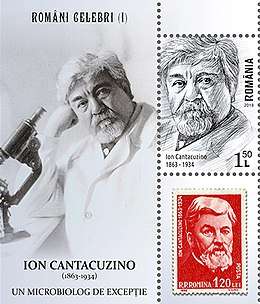Ioan Cantacuzino
Ioan I. Cantacuzino (Romanian pronunciation: [ˈjo̯an kantakuziˈno], also Ion Cantacuzino; 25 November 1863 – 14 January 1934) was a renowned Romanian physician and bacteriologist, a professor at the Romanian School of Medicine and Pharmacy and a member of the Romanian Academy. He established the fields of microbiology and experimental medicine in Romania, and founded the Ioan Cantacuzino Institute.

Early days
Born in Bucharest as a member of the Cantacuzino family, he graduated from the University of Paris' Faculty of Sciences and Faculty of Medicine, and worked at several hospitals in Paris, obtaining his doctorate in 1894. Later in the same year, he began his academic career as a deputy professor at the University of Iaşi, and returned to Paris after two years to serve on the staff of the Pasteur Institute, where he worked under the direction of Ilya Ilyich Mechnikov.
Career
In 1901, Cantacuzino was assigned a teaching position in Bucharest, where he became a major influence on a generation of scientists. His discoveries were relevant in the treatment of cholera, epidemic typhus, tuberculosis, and scarlet fever. As a disciple of Mechnikov, he devoted part of his research to expanding on the latter's field of interest (phagocytes, the body's means of defence against pathogens, as well as the issue of immunity and invertebrates). He invented the notion of contact immunity.
During the Second Balkan War, Cantacuzino was appointed head of the staff combatting the cholera epidemic in the ranks of the Romanian Army stationed in Dobruja; he was assigned to the same position during the Romanian campaign in World War I, in the fight against typhus. He founded and led the scientific magazines Revista Ştiinţelor Medicale and Archives roumaines de pathologie expérimentale, and regularly contributed to the literary magazine Viața Românească (replacing Paul Bujor on the editorial board).[1] A collaborator of Constantin Stere, he was noted as a Poporanist disciple of Constantin Dobrogeanu-Gherea.[2]
References
- Constantin Stere, "Cum am devenit director al Vieţii Romîneşti [sic]" ("How I Became an Editor of Viața Românească"), in Viaţa Românească, 1&2/XXV, January–February 1933. p. 13
- (in Romanian) Mircea Vulcănescu, Şcoala sociologică a lui Dimitrie Gusti. IX: Semnificaţia generală a învăţământului gustian. euroweb.ro
External links
| Wikimedia Commons has media related to Ion Cantacuzino. |